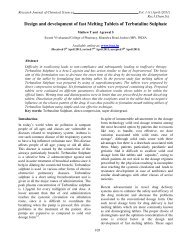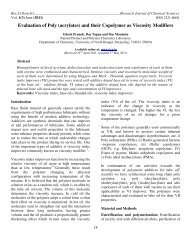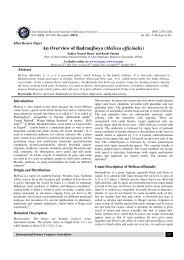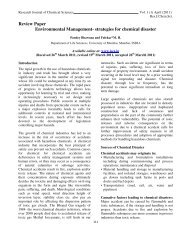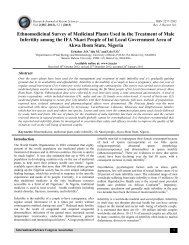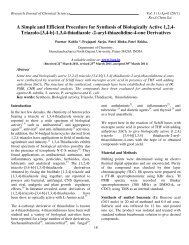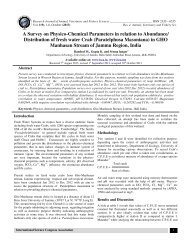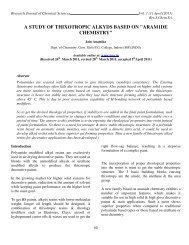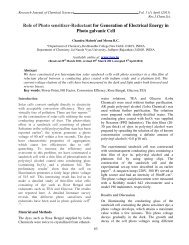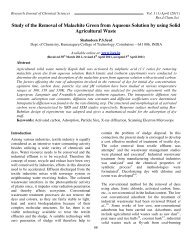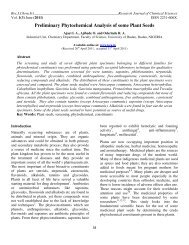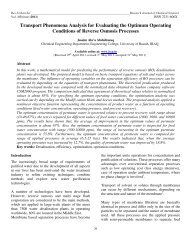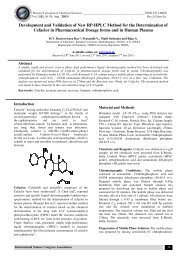Study of Carbonization for Cashew Nut Shell - ISCA
Study of Carbonization for Cashew Nut Shell - ISCA
Study of Carbonization for Cashew Nut Shell - ISCA
Create successful ePaper yourself
Turn your PDF publications into a flip-book with our unique Google optimized e-Paper software.
Res.J.Chem.Sci._____________________________________________Research Journal <strong>of</strong> Chemical Sciences<br />
Vol. 1(2), 43-55, May (2011) ISSN 2231-606X<br />
considerable attention in the areas <strong>of</strong> macrolide,<br />
plant growth, acid activity 8 , wood preservative and<br />
pressure treatment activity. Much <strong>of</strong> the biological<br />
activity is attributed to the anacardic acids, which are<br />
the major constituents <strong>of</strong> the cashew nutshells, along<br />
with cardols. However, the major constituents <strong>of</strong> the<br />
technical CNSL, as it is obtained in the current<br />
industrial practice <strong>of</strong> roasting or hot oil bath<br />
methods 19 , are the cardols and cardanols. In the<br />
carbonization process, solid residues with increasing<br />
content <strong>of</strong> carbon element <strong>of</strong> higher activation<br />
energy 20 are <strong>for</strong>med from organic material usually<br />
by pyrolysis in an inert atmosphere. Char<br />
preparation by this method will help in self-reliance<br />
<strong>of</strong> cashew processing unit <strong>for</strong> fuel supply with<br />
higher combustion efficiency. Keeping this view, the<br />
present study was undertaken.<br />
Material and Methods<br />
The cashew nut shell available in the cashew<br />
processing industry was selected as a major raw<br />
material 4 <strong>for</strong> the carbonization process. The<br />
proximate 21,7 and ultimate analysis 3 <strong>of</strong> CNS was<br />
carried out to find out the fuel properties. In addition<br />
to CNS properties, carbonization processes were<br />
studied using metal kiln and tin boxes under direct<br />
and indirect process.<br />
Experimental set up <strong>for</strong> carbonization <strong>of</strong> cashew<br />
nut shell: The carbonization <strong>of</strong> CNS was carried 22<br />
out in developed small capacity single drum kiln 23 ,<br />
which accommodate about 5 kg cashew nut shells.<br />
The kiln (plate 1.a) was designed with 8 mm<br />
diameter holes <strong>for</strong> the per<strong>for</strong>ations with outlet <strong>for</strong> the<br />
oil at the bottom and vent <strong>for</strong> the exhaust at the top<br />
(plate 1c). The size selected was suitable <strong>for</strong> small<br />
amount <strong>of</strong> burning, low cost and fabrication could be<br />
developed locally. Design detail specification <strong>of</strong> kiln<br />
is depicted in table 1. At the beginning, the small<br />
vent at the top and the oil collecting tube at bottom<br />
allowed the burning <strong>of</strong> the cashew nut shells, and<br />
then operated as the pyrolysis mode in a closed kiln<br />
without air. Kiln was evaluated with and without<br />
per<strong>for</strong>ated hole. The selected small capacity kiln was<br />
used <strong>for</strong> direct carbonization process (plate 1.a). The<br />
eight <strong>of</strong> raw CNS was measured and filled the kiln<br />
with full capacity and burn directly. Various<br />
temperatures at different location under kiln, exhaust<br />
temperature <strong>of</strong> vent and oil collected from the<br />
bottom sump were observed periodically. Time<br />
require to complete carbonization process and<br />
amount <strong>of</strong> char remain in kiln was observed at the<br />
end <strong>of</strong> process. The detailed flow chart <strong>of</strong><br />
carbonization processed used is shown in fig.2.<br />
Direct heating method <strong>of</strong> carbonization: Sample<br />
<strong>of</strong> the cashew nut shell was weighed and recorded.<br />
Developed kiln was checked <strong>for</strong> any leakage and<br />
which could not generate heat loss. The wire mesh<br />
grate was kept <strong>for</strong> support at the bottom <strong>of</strong> the kiln.<br />
The height <strong>of</strong> the great support was 6 cm above the<br />
bottom and would act as a convective heat media <strong>for</strong><br />
the partial oxidation process, which would make<br />
heat, flow inside the kiln become more effective.<br />
Kiln was closed after placing the CNS <strong>for</strong> the<br />
carbonization; initial start up firing 24 was done using<br />
loose grass 25 that would transfer the heat to the CNS.<br />
Continuous observations were done to know the<br />
transfer <strong>of</strong> heat; the kiln air inlet size was adjusted<br />
based on the changes observed at the exhaust. Inside<br />
temperature <strong>of</strong> the CNS, outside temperature <strong>of</strong> the<br />
kiln and temperature <strong>of</strong> the exhaust fumes were<br />
recorded <strong>for</strong> the every 60 minutes. The time was<br />
recorded and the carbonization stage changes were<br />
noticed.<br />
The kiln was continuously observed to see the<br />
smoke colour change from blue to light blue, it<br />
found that all the CNS had turned to charcoal;<br />
during that stage the light blue smoke would become<br />
clearer. The kiln was allowed to cool down <strong>for</strong> 8<br />
hours. After that, ash and char were separated,<br />
weighed and recorded.<br />
Indirect heating method <strong>of</strong> carbonization: Two<br />
small tin boxes having 0.3 kg capacity were selected<br />
<strong>for</strong> the indirect heating method <strong>of</strong> the carbonization<br />
(plate 1.b). The hole was made at the center <strong>of</strong> the<br />
tin box lid in order to remove the volatile matter and<br />
moisture associated with it. These tin boxes were<br />
placed inside the kiln and were surrounded by the<br />
cashew nut shells. Sample <strong>of</strong> the cashew nut shell<br />
were weighed and recorded. Prepared kiln was<br />
International Science Congress Association 44



